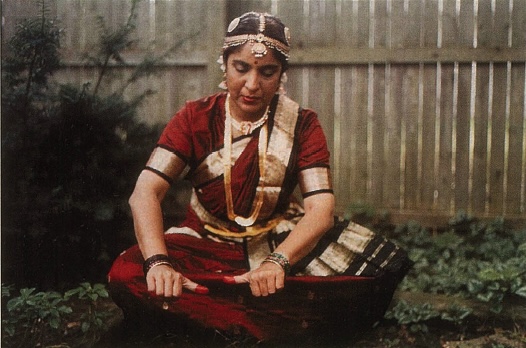By Lavina Melwani
She’s a natural, and a more enthusiastic spokesperson for nature would be hard to find. Manju Prasad Rao, a Long Island-based educator, has made it her life’s mission to spread the word about India’s ancient and rich treasury of plants and flowers. She stresses how they remain relevant even as we head toward the next millennium. By delving into literature, art and myth, Rao–Director of the Instructional Media Center at the C.W. Post Campus of the Long Island University and the coordinator for exhibits in the library–orchestrates music and dance along with magical tales of the vibrant role plants and flowers have played through the centuries.
Rao’s inspiration for her presentations actually came from an article she read in Hinduism Today. The Sacred Plants Resort [April, 1996 ] is about 200 miles from Bangalore, Rao’s hometown, and she couldn’t resist a visit. “I saw wonderful plants and trees, all labeled with names of rishis and Deities from the Hindu tradition.” It was as if she had stumbled into a magic garden, full of promise and possibility. Childhood memories rushed in–temple flower stalls brimming with offerings for the Gods and her mother worshiping tulsi, sacred basil, in the early morning. “I saw the way we unite with the trees and plants through the elements, and the way even the Deities unite with the plants. I remembered the way my mother, who belonged to the Arya Samaj, did yagnas, fire ceremony, every day. We as children used to have fun adding the samagri (a specific mixture of herbs) to the fire. Or she would put me in charge of adding ghee to the flames. She would do this every day, methodically. It was the most special part of her day. It gave her peace and sanctity.”
Sensing the history of India’s rich multiplicity of plants triggered a rare response in Rao. “Suddenly, everything started to jell. By tradition, I’m also a dancer. So I saw how these plants and trees are associated with themes in literature, art and dance. I’m not a botanist, so the plants appealed to me more in a theatrical way. I was interested in the performing angle, in capturing it and presenting it intelligently.”
Rao has since gathered countless anecdotes and fables from the Jataka and Panchantantra tales, as well as Buddhist parables. She has been studying Carnatic music for the last ten years, and found that plants are mentioned in all the ashtapadas (the “songs in eight stanzas” of the Gita Govinda). “I saw how much importance nature was given. There is such a harmony and unity of life in the older traditions. The forest is not viewed as something barbaric. It is where you regenerate yourself.”
Rao’s informative, entertaining lectures take viewers from the Indus Valley civilization, through Vedic times, to the Mughal empire and the British Raj. She emphasizes the great respect shown to plant life in the Hindu tradition, explaining, “I tie in the rituals which were related to each fruit, plant or action. If you had to cut down a tree to erect a structure, the tree spirit had to be given an alternate residence. The move had to be sanctified with rituals. Even if flowers were plucked for worship, they had to be taken in a certain way, and never after dusk, when the plants are thought to be sleeping. Fruits were also usually allowed to fall to the ground before being picked, because then the seeds inside would germinate.”
Rao has given several slide lectures in the university, which include narrating the story of plants through dance, visuals and music. She has given presentations at the Aurobindo Ashram, the Museum of Natural History, the Bayard Arboretum and the Tibetan Museum. For several performances she formed a troupe with Melinda Levokove and Lonnie McGuire, whom she also trained for a year.
Rao married a chemical engineer and has one young son. They live in the Long Island suburbs where she grows hibiscus and jasmine, both tropical plants. She would be the first to admit that her newfound organic awareness has only just germinated. She reflects, “We are made of the same substance as they, and I often wonder at what level they exist in terms of their feelings. I’m certainly more aware of them now, knowing that we have this oneness, and that we are molded by the same creator.”
MANJU PRASAD RAO, 152 FIDDLER PLACE, WEST ISLIP, NEW YORK 11795 USA
